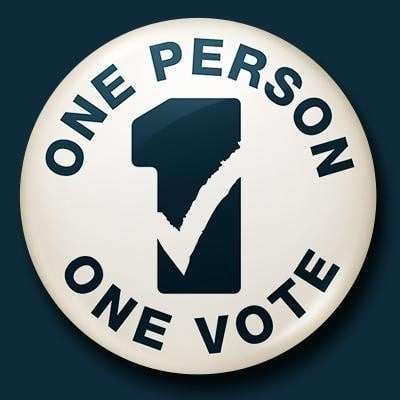The Volokh Conspiracy
Mostly law professors | Sometimes contrarian | Often libertarian | Always independent
Originalism and the "one person, one vote" principle

Well-known legal scholar Earl Maltz has an important new article arguing that Reynolds v. Sims (1965) and other Supreme Court decisions requiring state governments to follow the "one person, one vote" rule for apportioning legislative districts cannot be squared with the original meaning of the Constitution. Maltz also contends that this conclusion greatly weakens the case for originalism, perhaps to the point of undermining it completely. He emphasizes that an originalist judge faced with unequally apportioned state legislatures where some voters have much greater representation than others, will be "powerless to act against regimes that are structured in a manner that is completely inconsistent with the most fundamental tenets of democracy." These issues are particularly significant, as the Supreme Court is now considering a case about the meaning of the "one person, one vote" principle, and what it entails.
Maltz makes a strong case that the one person, one vote cases are incompatible with the original meaning of the Constitution. But his argument that this is a major strike against originalism is unpersuasive. Like Maltz, I agree that originalism should be judged at least in large part on consequentialist grounds: based on whether following its dictates will effectively promote such values as liberty, justice, and happiness. By its fruits shall originalism be known; and the same goes for rival theories, such as living constitutionalism. But this particular fruit is far more palatable than Maltz suggests. While no constitutional theory should be discarded because it leads to bad results on any one issue, it would indeed give me pause if—as some critics claim—originalism requires judges to uphold laws mandating racial segregation or forbidding interracial marriage. I have no such hesitation about allowing unequal apportionment.
Consider that not only originalists, but most living constitutionalists accept the highly unequal apportionment of the US Senate. California and Rhode Island have the exact same number of senators, even though the former has almost forty times the population of the latter. Yet few argue that this state of affairs "is completely inconsistent with the most fundamental tenets of democracy" and even fewer say we must reject any constitutional theory that allows the malapportionment of the Senate to continue. If highly unequal apportionment is defensible (or at least tolerable) at the federal level, why not among the states?
A malapportioned state legislature is actually less dangerous than a malapportioned Congress. Its laws affect fewer people, and those who suffer from them have better exit options; moving to another state is generally easier than leaving the country entirely. Moreover, most state constitutions are easier to amend than the federal Constitution is. States such as Arizona and Nebraska have addressed the problem of gerrymandering by delegating the task of drawing district lines to independent commissions. Perhaps the same approach would work with apportionment. State malapportionment is easier to fix through the political process than that at the federal level. Indeed, Article V of the the Constitution forbids depriving any state "of its equal Suffrage in the Senate" even by constitutional amendment, except in the unlikely event that the state gives its consent.
It is also worth noting that there are multiple plausible (and very different) interpretations of the "one person, one vote" principle. Should seats be apportioned based on total population, total number of citizens, total number of eligible voters, or the total number of legal residents? It would be unwise to have the Supreme Court impose any one of them on every part of the nation, thereby cutting off potentially useful experimentation—at least not unless it really was clear that one of them is required by the Constitution, or at least by any reasonable interpretation of democratic theory.
Finally, states might have good reasons to give extra weight to some districts, relative to others. Before Reynolds, the most common form of unequal apportionment was one in which rural districts got greater weight relative to urban ones. But urban areas have relatively greater concentrations of celebrities, intellectuals, academics, journalists, lobbyists, unionized public employees, and others who wield disproportionate political influence by means other than voting. Giving extra voting power to rural areas may, at least in part, simply counterbalance these advantages of city-dwellers. Other types of unequal apportionment might also help offset non-electoral forms of political inequality.
Inequalities in apportionment might also, in some cases, help diminish the negative effects of widespread political ignorance by giving greater weight to areas with higher proportions of relatively well-informed voters. Because of concerns about ignorance and poor judgment, we already exclude large numbers of people from the franchise entirely (children, many of the mentally ill, convicted felons, and immigrants who can't pass a civic knowledge test). It should not be entirely out of bounds to pursue the same objective through the less drastic remedy of unequal apportionment, which at least does not completely exclude anyone from the franchise.
None of this suggests that unequal apportionment is always a good thing, or even most of the time. Perhaps, on balance, it still does more harm than good. But unequal apportionment is not the kind of great evil whose perpetuation should serve to discredit originalism or any other constitutional theory that allows it to continue. In some cases, it might even be a feature of the Constitution rather than a bug.
To get the Volokh Conspiracy Daily e-mail, please sign up here.

Show Comments (0)